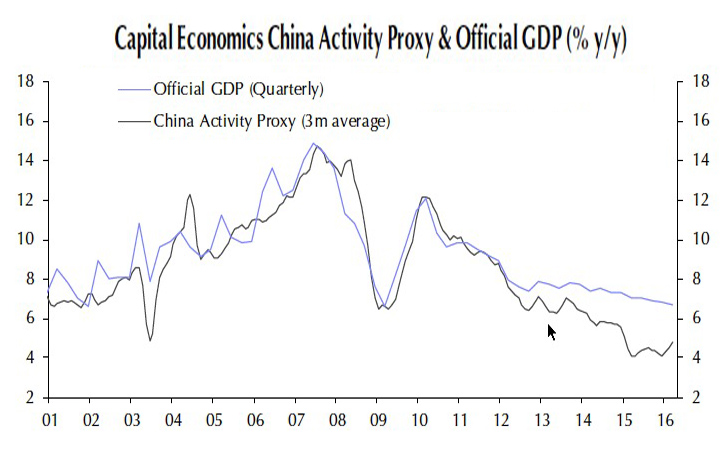This chart shows actual China GDP growth highest since 2014

In March Chinese leaders detailed the country’s 13th five-year plan running from 2016 – 2020 which doubles-down on a long-stated commitment to “double 2010 GDP by 2020”.
The 2020 GDP goal would require annual growth rates of 6.5% to go from a nominal $10 trillion last year to over $12 trillion in 2020. That’s the equivalent of adding an economy the size of Switzerland’s every year.
China’s official GDP data released two weeks ago showed growth of 6.7%, boosted in no small measure by a raft of stimulus measures introduced by Beijing that has seen a number of metrics improve dramatically since the start of the year.
Manufacturing activity hit a more-than-one-year high, fixed asset investment and industrial output all improved while real estate statistics indicated stronger investment. Property prices shot up, imports of commodities hit monthly records and bank lending hit an all-time high.
“That is still much slower than the official figures will show but a strong growth rate for a country at China’s income level”
Skepticism about official Chinese growth figures abound, and most peg actual GDP expansion at a much lower clip.
Independent research house Capital Economics’ measure of the Chinese economy uses a combination of weighted data including electricity usage, seaport cargoes, floor space under construction and passenger and freight traffic to gauge activity across a wide section of the economy.
According to Capital Economics research, China’s GDP growth rates came close to dropping below 4% early last year and again at the beginning of 2016.
But since then growth has picked up markedly hitting 4.8% in the first quarter of the year.
That’s the highest since Q4 2014 and according to China economists, Mark Williams and Julian Evans-Pritchard, all but one of the components of Capital Economics’ China Activity Proxy showed strong improvement. While passenger traffic was weak it was mostly due to seasonal effects – last year in March numbers peaked because the Chinese New Year fell unusually late in 2015.
The authors of the report expect growth to accelerate further over the next couple of quarters on the back of monetary easing that is already in the pipeline and the ongoing front-loading of this year’s fiscal support.
“We continue to expect growth on our China Activity Proxy to average 5.5% this year. That is still much slower than the official figures will show but a strong growth rate for a country at China’s income level.”

Source: Capital Economics
{{ commodity.name }}
{{ post.title }}
{{ post.date }}

Comments
China Lee
Capital Economics Research is using the wrong factors in their proxy measure for China’s economic activity.
To quote from the article: “Independent research house Capital Economics’ measure of the Chinese economy uses a combination of weighted data including electricity usage, seaport cargoes, floor space under construction and passenger and freight traffic to gauge activity across a wide section of the economy.”
Capital Economics is only measuring China’s manufacturing economy. Everybody knows that China’s manufacturing sector has plateaued quantitatively. The Chinese manufacturing sector has matured and electricity consumption growth has slowed.
However, China’s manufacturing sector is growing qualitatively. China is building more supercomputers, CNC machine tools, industrial robots, high-tech DFH-4 telecommunications satellites, billion-dollar offshore oil platforms, ARJ-21 commercial jets, etc. than ever.
Also, China’s services sector is growing dramatically. This is seen in Alibaba’s (e.g. China’s Amazon and Ebay) stellar sales growth. Similar dramatic sales and earnings growth is occurring at Baidu, Tencent, Didi Kuaidi (e.g. China’s Uber), etc.
In conclusion, Capital Economics’ proxy measure fails to capture China’s qualitative improvement in manufacturing. You can use the same amount of electricity and raw materials to manufacture far more technologically-advanced products (such as Huawei’s gigabit switches and wireless routers for telecommunications). Also, the majority of China’s economic growth has shifted to the services sector. Capital Economics fails to measure BOTH of these important Chinese economic growth engines.